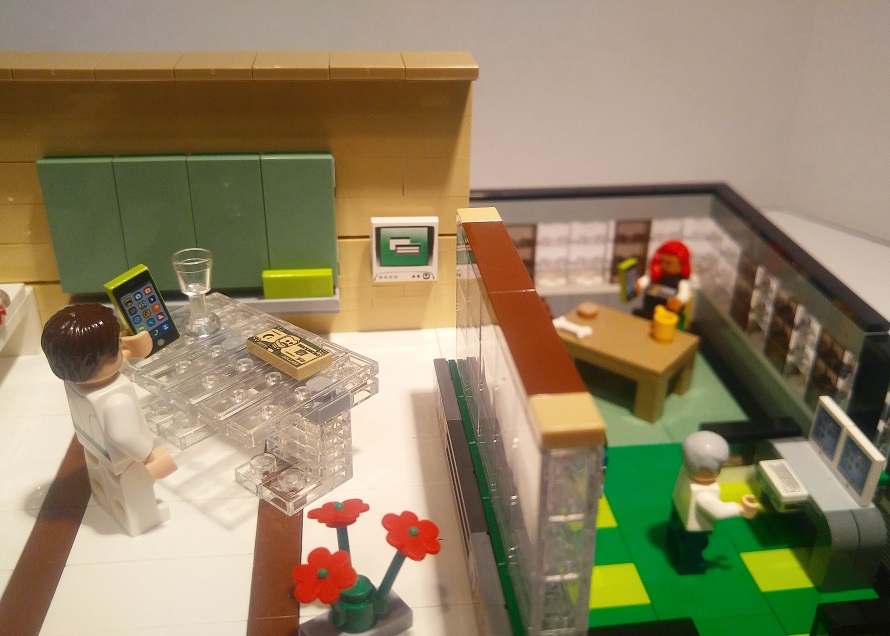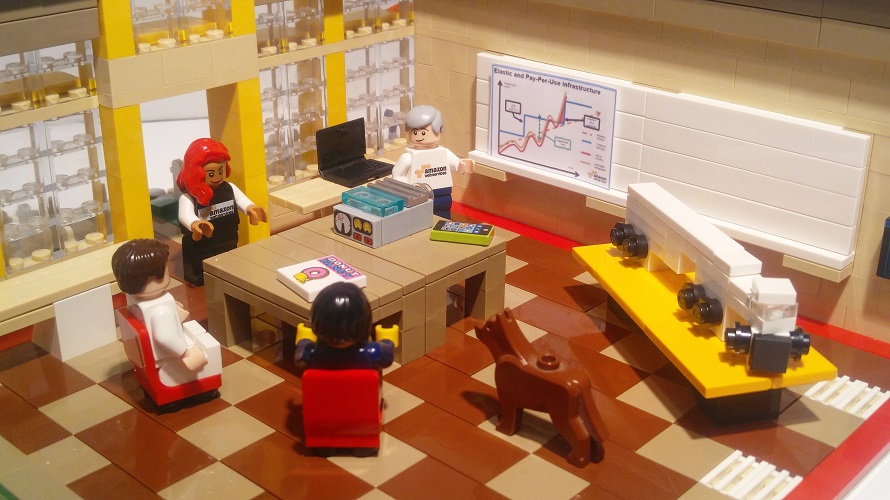Adventure Through the Amazon
Wednesday, November 30, 2016
A Premium Alexa Speaker with 7-inch Touchscreen?
Bringing the Magic of Amazon AI and Alexa to Apps on AWS.

From the early days of Amazon, Machine learning (ML) has played a critical role in the value we bring to our customers. Around 20 years ago, we used machine learning in our recommendation engine to generate personalized recommendations for our customers. Today, there are thousands of machine learning scientists and developers applying machine learning in various places, from recommendations to fraud detection, from inventory levels to book classification to abusive review detection. There are many more application areas where we use ML extensively: search, autonomous drones, robotics in fulfillment centers, text processing and speech recognition (such as in Alexa) etc.
Among machine learning algorithms, a class of algorithms called deep learning has come to represent those algorithms that can absorb huge volumes of data and learn elegant and useful patterns within that data: faces inside photos, the meaning of a text, or the intent of a spoken word.After over 20 years of developing these machine learning and deep learning algorithms and end user services listed above, we understand the needs of both the machine learning scientist community that builds these machine learning algorithms as well as app developers who use them. We also have a great deal of machine learning technology that can benefit machine scientists and developers working outside Amazon. Last week, I wrote a blog about helping the machine learning scientist community select the right deep learning framework from among many we support on AWS such as MxNet, TensorFlow, Caffe, etc.
Today, I want to focus on helping app developers who have chosen to develop their apps on AWS and have in the past developed some of the seminal apps of our times on AWS, such as Netflix, AirBnB, or Pinterest or created internet connected devices powered by AWS such as Alexa and Dropcam. Many app developers have been intrigued by the magic of Alexa and other AI powered products they see being offered or used by Amazon and want our help in developing their own magical apps that can hear, see, speak, and understand the world around them.
For example, they want us to help them develop chatbots that understand natural language, build Alexa-style conversational experiences for mobile apps, dynamically generate speech without using expensive voice actors, and recognize concepts and faces in images without requiring human annotators. However, until now, very few developers have been able to build, deploy, and broadly scale applications with AI capabilities because doing so required specialized expertise (with Ph.D.s in ML and neural networks) and access to vast amounts of data. Effectively applying AI involves extensive manual effort to develop and tune many different types of machine learning and deep learning algorithms (e.g. automatic speech recognition, natural language understanding, image classification), collect and clean the training data, and train and tune the machine learning models. And this process must be repeated for every object, face, voice, and language feature in an application.
Today, I am excited to announce that we are launching three new Amazon AI services that eliminate all of this heavy lifting, making AI broadly accessible to all app developers by offering Amazon's powerful and proven deep learning algorithms and technologies as fully managed services that any developer can access through an API call or a few clicks in the AWS Management Console. These services are Amazon Lex, Amazon Polly, and Amazon Rekognition that will help AWS app developers build these next generation of magical, intelligent apps. Amazon AI services make the full power of Amazon's natural language understanding, speech recognition, text-to-speech, and image analysis technologies available at any scale, for any app, on any device, anywhere.
Amazon Lex
After the launch of the Alexa Skill Kit (ASK), customers loved the ability to build voice bots or skills for Alexa. They also started asking us to give them access to the technology that powers Alexa, so that they can add a conversational interface (using voice or text) to their mobile apps. They also wanted the capability to publish their bots on chat services like Facebook Messenger and Slack.
Amazon Lex is a new service for building conversational interfaces using voice and text. The same conversational engine that powers Alexa is now available to any developer, making it easy to bring sophisticated, natural language 'chatbots' to new and existing applications. The power of Alexa in the hands of every developer, without having to know deep learning technologies like speech recognition, has the potential of sparking innovation in entirely new categories of products and services. Developers can now build powerful conversational interfaces quickly and easily, that operate at any scale, on any device.

The speech recognition and natural language understanding technology behind Amazon Lex and Alexa is powered by deep learning models that have been trained on massive amounts of data. Developers can simply specify a few sample phrases and the information required to complete a user's task, and Lex builds the deep learning based intent model, guides the conversation, and executes the business logic using AWS Lambda. Developers can build, test, and deploy chatbots directly from the AWS Management Console. These chatbots can be accessed anywhere: from web applications, chat and messenger apps such as Facebook Messenger (with support for exporting to Alexa Skills Kit and Slack support coming soon), or connected devices. Developers can also effortlessly include their Amazon Lex bots in their own iOS and Android mobile apps using the new Conversational Bots feature in AWS Mobile Hub.
Recently, a few selected customers participated in a private beta of Amazon Lex. They provided us with valuable feedback as we rounded off Amazon Lex for a preview launch. I am excited to share some of the feedback from our beta customers HubSpot and Capital One.
HubSpot, a marketing and sales software leader, uses a chatbot called GrowthBot to help marketers and sales personnel be more productive by providing access to relevant data and services. Dharmesh Shah, HubSpot CTO and Founder, tells us that Amazon Lex enabled sophisticated natural language processing capabilities on GrowthBot to provide a more intuitive UI for customers. Hubspot could take advantage of advanced AI and ML capabilities provided by Amazon Lex, without having to code the algorithms.
Capital One offers a broad spectrum of financial products and services to consumers, small businesses, and commercial clients through a variety of channels. Firoze Lafeer, CTO Capital One Labs, tells us that Amazon Lex enables customers to query for information through voice or text in natural language and derive key insights into their accounts. Because Amazon Lex is powered by Alexa's technology, it provides Capital One with a high level of confidence that customer interactions are accurate, allowing easy deployment and scaling of bots.
Amazon Polly
The concept of a computer being able to speak with a human-like voice goes back almost as long as ENIAC (the first electronic programmable computer). The concept has been explored by many popular science fiction movies and TV shows, such as "2001: A Space Odyssey" with HAL-9000 or the Star Trek computer and Commander Data, which defined the perception of computer-generated speech.
Text-to-speech (TTS) systems have been largely adopted in a variety of real-life scenarios such as telephony systems with automated speech responses or help for visually or speech-impaired people. Prof. Stephen Hawking's voice is probably the most famous example of synthetic speech used to help the disabled.
TTS systems have continuously evolved through the last few decades and are nowadays capable of delivering a fairly natural-sounding speech. Today, TTS is used in a large variety of use cases and is turning into a ubiquitous element of user interfaces. Alexa and its TTS voice is yet another step towards building an intuitive and natural language interface that follows the pattern of human communication.
With Amazon Polly, we are making the same TTS technology used to build Alexa's voice to AWS customers. It is now available to any developer aiming to power their apps with high-quality spoken output.
In order to mimic human speech, we needed to address a variety of challenges. We needed to learn how to interpret various text structures such as acronyms, abbreviations, numbers, or homographs (words spelled the same but pronounced differently and having different meanings). For example:
I heard that Outlander is a good read, though I haven't read it yet, or
or
St. Mary's Church is at 226 St. Mary's St.
Last but not least, as the quality of TTS gets better and better, we expect a natural intonation matching the semantics of synthesized texts. Traditional rule-based models and ML techniques, such as classification and regression trees (CART) and hidden Markov models (HMM) present limitations to model the complexity of this process. Deep learning has shown its capacity in representing complex and nonlinear relationships at different levels of speech synthesis process. The TTS technology behind Amazon Polly takes advantage of bidirectional long short-term memory (LSTM) networks using a massive amount of data to train models that convert letters to sounds and predict the intonation contour. This technology enables high naturalness, consistent intonation, and accurate processing of texts.
Amazon Polly customers have confirmed the high quality of generated speech for their use cases. Duolingo uses Amazon Polly voices for language learning applications, where quality is critical. Severin Hacker, the CTO of Duolingo, acknowledged that Amazon Polly voices are not just high in quality, but are as good as natural human speech for teaching a language.
The Royal National Institute of Blind People uses the Amazon TTS technology to support the visually impaired through their largest library of books in the UK. John Worsfold, Solutions Implementation Manager at RNIB, confirmed that Amazon Polly's incredibly lifelike voices captivate and engage RNIB readers.
Amazon Rekognition
We live in a world that is undergoing digital transformation at a rapid rate. One key outcome of this is the explosive growth of images generated and consumed by applications and services across different segments and industries. Whether it is a consumer app for photo sharing or printing, or the organization of images in the archives of media and news organizations, or filtering images for public safety and security, the need to derive insight from the visual content of the images continues to grow rapidly.
There is an inherent gap between the number of images created and stored, and the ability to capture the insight that can be derived from these images. Put simply, most image stores are not searchable, organized, or actionable. While a few solutions exist, customers have told us that they don't scale well, are not reliable, are too expensive, rely on complex pipelines to annotate, verify, and process massive amount of data for training and testing algorithms, need a team of highly specialized and skilled data scientists, and require costly and highly specialized hardware. For companies that have successfully built a pipeline for image analysis, the processes of maintaining, improving, and keeping up with the research in this space proves to be high friction. Amazon Rekognition solves these problems.
Amazon Rekognition is a fully managed, deep-learning–based image analysis service, built by our computer vision scientists with the same proven technology that has already analyzed billions of images daily on Amazon Prime Photos. Amazon Rekognition democratizes the application of deep learning technique for detecting objects, scenes, concepts, and faces in your images, comparing faces between two images, and performing search functionality across millions of facial feature vectors that your business can store with Amazon Rekognition. Amazon Rekognition's easy-to-use API, which is integrated with Amazon S3 and AWS Lambda, brings deep learning to your object store.
Getting started with Rekognition is simple. Let's walk through some of the core features of Rekognition that help you build powerful search, filter, organization, and verification applications for images.
Object and scene detection
Given an image, Amazon Rekognition detects objects, scenes, and concepts and then generates labels, each with a confidence score. Businesses can use this metadata to create searchable indexes for social sharing and printing apps, categorization for news and media image archives, or filters for targeted advertisement. If you are uploading your images to Amazon S3, it is easy to invoke an AWS Lambda function that passes the image to Amazon Rekognition and persist the labels with confidence scores into an Elasticsearch index.

Facial Analysis
With any given image, you can now detect faces present, and derive face attributes like demographic information, sentiment, and key landmarks from the face. With this fast and accurate API, retail businesses can respond to their customers online or in store immediately by delivering targeted ads. Also, these attributes can be stored in Amazon Redshift to generate deeper insights of their customers.

Face recognition
Amazon Rekognition's face comparison and face search features can provide businesses with face-based authentication, verification of identity, and the ability to detect the presence of a specific person in a collection of images. Whether simply comparing faces present in two images using CompareFaces API, or creating a collection of faces by invoking Amazon Rekognition's IndexFace API, businesses can rely on our focus on security and privacy, as no images are stored by Rekognition. Each detected face is transformed into an irreversible vector representation, and this feature vector (and not the underlying image itself) is used for comparison and search.

I am pleased to share some of the positive feedbacks from our beta customers.
Redfin is a full-service brokerage that uses modern technology to help people buy and sell houses. Yong Huang, Director of Big Data & Analytics, Redfin, tell us that Redfin users love to browse images of properties on their site and mobile apps and they want to make it easier for their users to sift through hundreds of millions of listing and images. He also added that Amazon Rekognition generates a rich set of tags directly from images of properties. This makes it relatively simple for them to build a smart search feature that helps customers discover houses based on their specific needs. And, because Amazon Rekognition accepts Amazon S3 URLs, it is a huge time-saver for them to detect objects, scenes, and faces without having to move images around.
Summing it all up
We are in the early days of machine learning and artificial intelligence. As we say in Amazon, we are still in Day 1. Yet, we are already seeing the tremendous value and magical experience Amazon AI can bring to everyday apps. We want to enable all types of developers to build intelligence in to their applications. For data scientists, they can use our P2 instances, Amazon EMR Spark MLLib, deep learning AMIs, MxNet and Amazon ML to build their own ML models. For app developers, we believe that these three Amazon AI services enable them to build next-generation apps to hear, see, and speak with humans and the world around us.
We'll also be hosting a Machine Learning " State of the Union" that covers all the three new AmazonAI services announced today along with demos from Motorola Solutions and Ohio Health – head over to Mirage (as we added more seating!). Also, we have a series of breakout sessions on using MXNet at AWS re:Invent on November 30th at the Mirage Hotel in Las Vegas.
AWS Snowmobile – Move Exabytes of Data to the Cloud in Weeks
Moving large amounts of on-premises data to the cloud as part of a migration effort is still more challenging than it should be! Even with high-end connections, moving petabytes or exabytes of film vaults, financial records, satellite imagery, or scientific data across the Internet can take years or decades. On the business side, adding new networking or better connectivity to data centers that are scheduled to be decommissioned after a migration is expensive and hard to justify.
Last year we announced the AWS Snowball (see AWS Snowball – Transfer 1 Petabyte Per Week Using Amazon-Owned Storage Appliances for more information) as a step toward addressing large-scale data migrations. With 80 TB of storage, these appliances address the needs of many of our customers, and are in widespread use today.
However, customers with exabyte-scale on-premises storage look at the 80 TB, do the math, and realize that an all-out data migration would still require lots of devices and some headache-inducing logistics.
Introducing AWS Snowmobile
In order to meet the needs of these customers, we are launching Snowmobile today. This secure data truck stores up to 100 PB of data and can help you to move exabytes to AWS in a matter of weeks (you can get more than one if necessary). Designed to meet the needs of our customers in the financial services, media & entertainment, scientific, and other industries, Snowmobile attaches to your network and appears as a local, NFS-mounted volume. You can use your existing backup and archiving tools to fill it up with data destined for Amazon Simple Storage Service (S3) or Amazon Glacier.
Physically, Snowmobile is a ruggedized, tamper-resistant shipping container 45 feet long, 9.6 feet high, and 8 feet wide. It is water-proof, climate-controlled, and can be parked in a covered or uncovered area adjacent to your existing data center. Each Snowmobile consumes about 350 kW of AC power; if you don't have sufficient capacity on site we can arrange for a generator.
On the security side, Snowmobile incorporates multiple layers of logical and physical protection including chain-of-custody tracking and video surveillance. Your data is encrypted with your AWS Key Management Service (KMS) keys before it is written. Each container includes GPS tracking, with cellular or satellite connectivity back to AWS. We will arrange for a security vehicle escort when the Snowmobile is in transit; we can also arrange for dedicated security guards while your Snowmobile is on-premises.
Each Snowmobile includes a network cable connected to a high-speed switch capable of supporting 1 Tb/second of data transfer spread across multiple 40 Gb/second connections. Assuming that your existing network can transfer data at that rate, you can fill a Snowmobile in about 10 days.
Snowmobile in Action
I don't happen to have an exabyte-scale data center and I certainly don't have room next to my house for a 45 foot long container. In order to illustrate the process of arranging for and using a Snowmobile, I sat down at my LEGO table and (in the finest Doc Brown tradition) built a scale model. I hope that you enjoy this brick-based story telling!
Let's start in your data center. It was built a while ago and is definitely showing its age. The racks are full of disk and tape drives of multiple vintages, each storing precious, mission-critical data. You and your colleagues spend too much time inside of the raised floor, tracking cables and trying to squeeze out just a bit more performance:

Your manager is getting frustrated and does not know what to do next:

Fortunately, one of your colleagues reads this blog every day and she knows just what to do:

A quick phone call to AWS and a meeting is set up:

Everyone gets together at a convenient AWS office to learn more about Snowmobile and to plan the migration:

Everyone gathers around to look at the scale model of the Snowmobile. Even the dog is intrigued, and your manager takes a picture:

A Snowmobile shows up at your data center:

AWS Professional Services helps you to get it connected and you initiate the data transfer:

The Snowmobile heads back to AWS and your data is imported as you specified!
Snowmobile at DigitalGlobe
Our friends at DigitalGlobe are using a Snowmobile to move 100 PB of satellite imagery to AWS. Here's what Jay Littlepage (former Amazonian and now VP of Infrastructure & Operations at DigitalGlobe) has to say about this effort:
 Like many large enterprises, we are in the process of migrating IT operations from our data centers to AWS. Our geospatial big data platform, GBDX, has been based in AWS since inception. But our unmatchable 16-year archive of high-resolution satellite imagery, visualizing 6 billion square kilometers of the Earth's surface, has been stored within our facilities. We have slowly been migrating our archive to AWS but that process has been slow and inefficient. Our constellation of satellites generate more earth imagery each year (10 PB) than we have been able to migrate by these methods.
Like many large enterprises, we are in the process of migrating IT operations from our data centers to AWS. Our geospatial big data platform, GBDX, has been based in AWS since inception. But our unmatchable 16-year archive of high-resolution satellite imagery, visualizing 6 billion square kilometers of the Earth's surface, has been stored within our facilities. We have slowly been migrating our archive to AWS but that process has been slow and inefficient. Our constellation of satellites generate more earth imagery each year (10 PB) than we have been able to migrate by these methods.
We needed a solution that could move our 100 PB archive but could not find one until now with AWS Snowmobile. DigitalGlobe is currently migrating our entire raw imagery archive with one Snowmobile transfer directly into an Amazon Glacier Vault. AWS Snowmobile operators are providing an amazing customized service where they manage the configuration, monitoring, and logistics. Using Snowmobile's data transfer abilities will get our time-lapse imagery archive to the cloud more quickly, allowing our customers and partners to have access to uniquely massive data sets. By using AWS' elastic computing platform within GBDX, we will run distributed image analysis, revealing the pace and pattern of world-wide change on an extraordinary scale, with unprecedented speed, in a more cost-effective manner – prioritizing insights over infrastructure. Without Snowmobile, we would not have been able to transfer our extremely large volume of data in such a short time or create new business opportunities for our customers. Snowmobile is truly a game changer!
Things to Know
Here are a couple of final things you should know about Snowmobile:
Data Export – The initial launch is aimed at data import (on-premises to AWS). We do know that some of our customers are interested in data export, with a particular focus on disaster recovery (DR) use cases.
Availability – Snowmobile is available in all AWS Regions. As you can see from reading the previous section, this is not a self-serve product. My AWS Sales colleagues are ready to discuss your data import needs with you.
Pricing – I don't have pricing info to share. However, we intend to make sure that Snowmobile is both faster and less expensive than using a network-based data transfer model.
- Jeff;
PS – Check out my Snowmobile Photo Album for some high-res pictures of my creation. Special thanks to Matt Gutierrez (Symbionix) for the final staging and the photo shoot.
PPS – I will build and personally deliver (in exchange for a photo op and a bloggable story) Snowmobile models to the first 5 customers.
Tuesday, November 29, 2016
AWS Global Partner Summit – Report from re:Invent 2016
My colleague Dorothy Copeland is the General Manager for the AWS Global Partner Program. She attended the AWS Global Partner Summit here at AWS re:Invent today and sent a full report, published here as a guest post.
- Jeff;
 We just wrapped an eventful AWS Global Partner Summit at re:Invent. This full-day event is exclusive to AWS Partner Network (APN) Partners. This year, the event featured a keynote with senior AWS leaders, who discussed a number of APN launches, key trends in the market, and stories of APN Partners driving customer success on AWS. The APN team then hosted a number of business and technical sessions focused on topics intended to help APN Partners build a successful AWS-based business.
We just wrapped an eventful AWS Global Partner Summit at re:Invent. This full-day event is exclusive to AWS Partner Network (APN) Partners. This year, the event featured a keynote with senior AWS leaders, who discussed a number of APN launches, key trends in the market, and stories of APN Partners driving customer success on AWS. The APN team then hosted a number of business and technical sessions focused on topics intended to help APN Partners build a successful AWS-based business.
During the Summit, AWS announced that more than 10,000 new Partners have joined the APN in the past 12 months. For customers, this growth provides an expanded selection of software integrated with AWS from thousands of new APN Technology Partners, as well as thousands of new APN Consulting Partners that can help design, architect, build, migrate, and manage their workloads and applications on AWS. Let's take a look at some of the other announcements the APN team made during the Global Partner Summit this year.
During the Global Partner Summit keynote, attendees heard from a number of AWS executives, including:
- Terry Wise
- James Hamilton
- Dave McCann
- Mike Clayville
- Andy Jassy
The keynote also featured the following customer speakers:
- Dan Zelem, CTO, Johnson & Johnson
- Adam Japhet, Head of Technology Services Architecture & Design, Scholastic
Keynote Theme – Driving Customer Success & Innovation on AWS
The world's leading enterprises trust APN Partners to help them achieve the agility benefits of the AWS Cloud. The majority of the Fortune 500 and over 90 percent of Fortune 100 companies utilize APN Partner solutions and services. APN Partners have a unique opportunity to drive customer success on AWS by developing deep skills and specializations on AWS. And throughout the keynote, speakers discussed how APN Partners are successfully helping Enterprise customers drive digital transformation and innovation on AWS, along with key areas of opportunity for APN Partners moving forward. Of particular focus were opportunities APN Partners have to help customers migrate to AWS and maximize the benefits of AWS. Terry Wise discussed how AWS approaches Enterprise migrations, the value of next-generation cloud managed services for customers, and how APN Partners can deliver immense value to customers through automation and full lifecycle customer engagement. Terry also discussed the newly announced alliance with VMWare and VMWare Cloud on AWS. Speaking to innovation, Terry discussed the interesting ways that APN Partners are innovating with Amazon Alexa, and how the APN and Alexa teams work together to help APN Partners develop key Alexa skills.
APN Program Launches
The APN team announced a number of exciting launches during the keynote. Here's a summary, along with links to more information on the AWS Partner Network Blog:
- The AWS IoT Competency: Showcases industry-leading APN Consulting and Technology Partners that provide proven technology and/or implementation capabilities for a variety of IoT use cases including (though not limited to) intelligent factories, smart cities, energy, automotive, transportation, and healthcare.
- The AWS Financial Services Competency: Recognizes APN Consulting and Technology Partners offering services and solutions for customers in banking and payments, capital markets, and insurance.
- The AWS Service Delivery Program: Helps AWS customers find APN Partners with validated experience in specific AWS services and skills such as Amazon Aurora or delivering AWS GovCloud (US) Workloads.
- The AWS Public Sector Program: Helps qualified APN Partners build and accelerate their AWS Public Sector business.
- The AWS Partner Solutions Finder: Enables AWS customers to easily search, discover, and connect with APN Partners, based on their business needs.
Meet Our New AWS Premier Consulting Partners!
We set an extremely high bar for a Consulting Partner to make the Premier tier in the APN (learn more here). We currently have 55 Premier Partners.
Congratulations to the following companies who we announced today have become AWS Premier Consulting Partners:
- Beeva
- Cascadeo
- Claranet Groupe
- InfoReliance
- NEC
- NTT DATA CORPORATION
- Rackspace
- Tata Consultancy Services (TCS)
Join the APN Team at re:Invent
Do you want to learn more about the APN? Visit the APN team at the main AWS booth throughout the week!